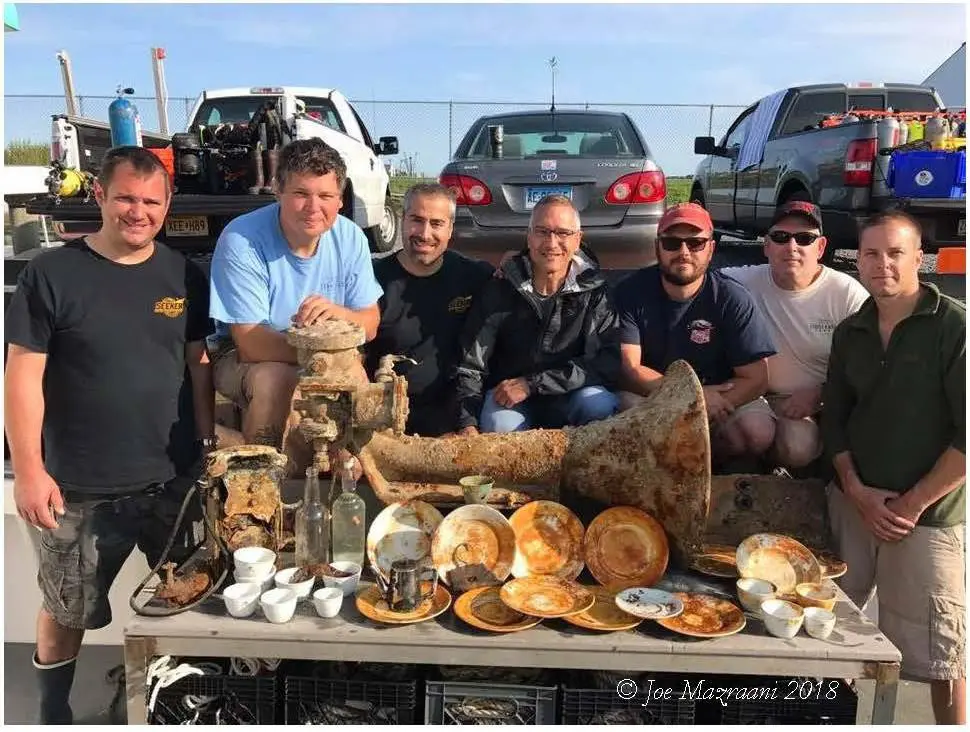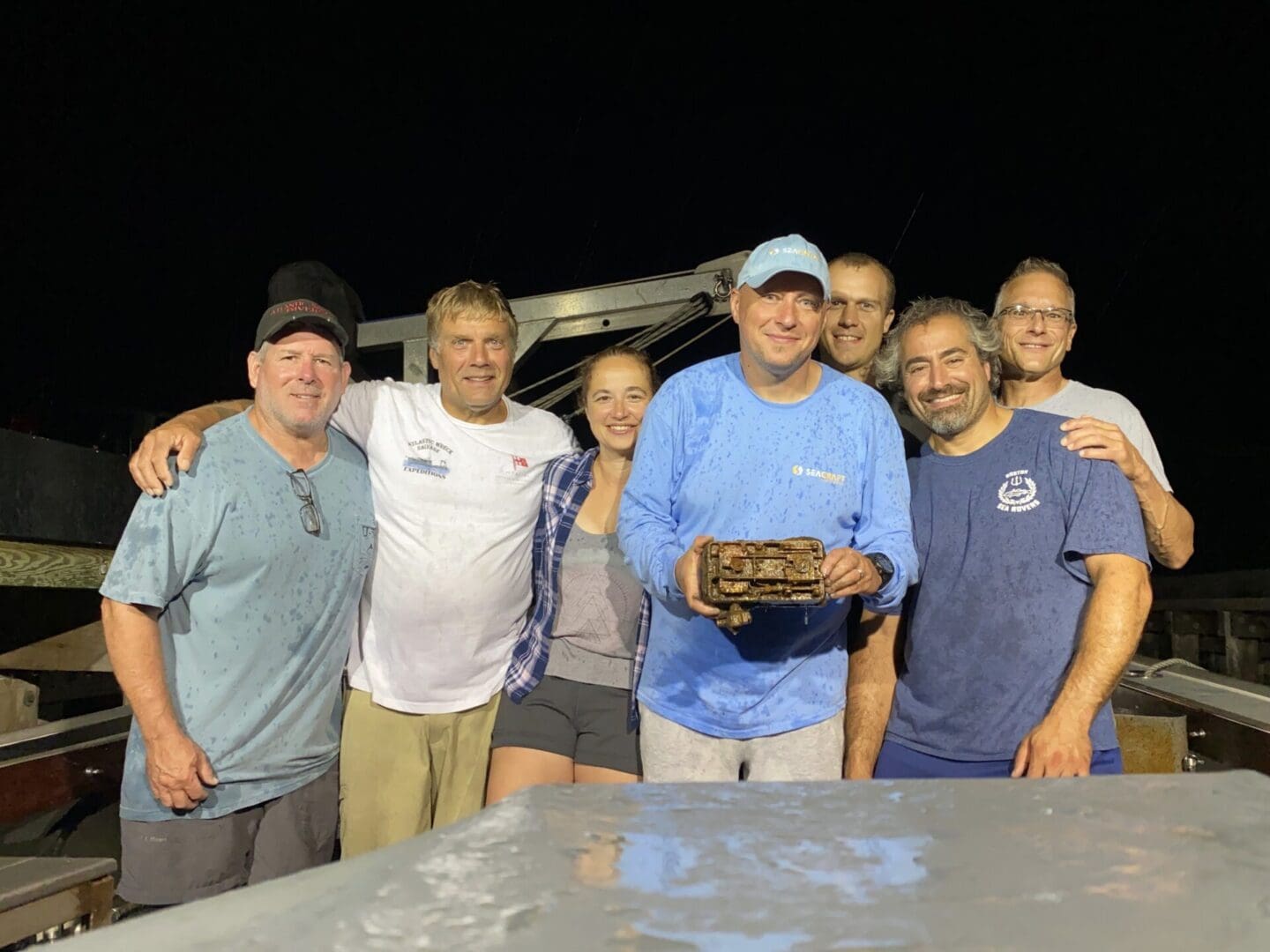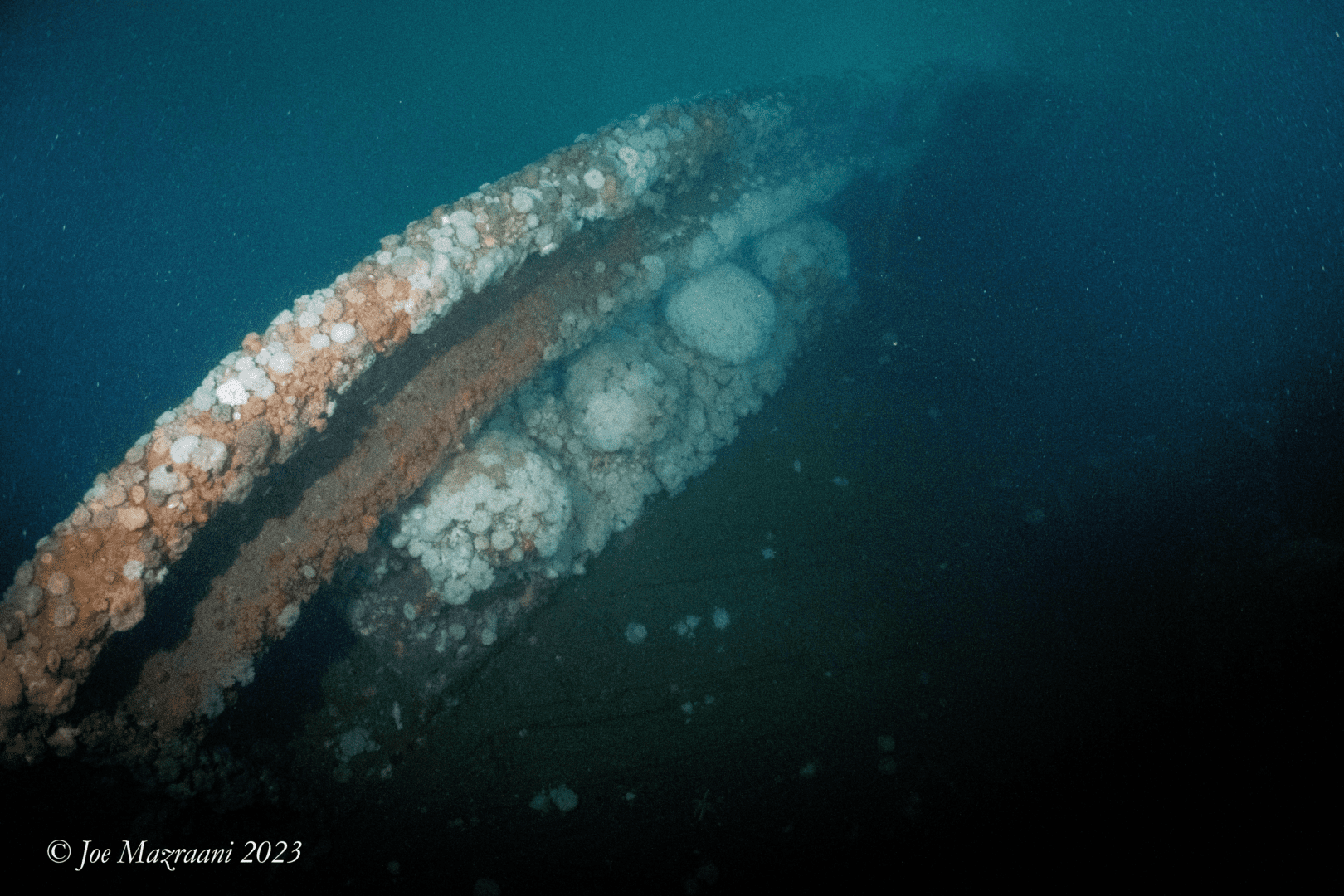SS Andrea Doria

SS Andrea Doria and MS Stockholm
SS Andrea Doria is hallowed ground for shipwreck divers. Divers from all over the world, particularly those who have cut their teeth in the waters of the North Atlantic, dream of one day exploring the wreck. She is located approximately 100 miles from Montauk Point and lays at a depth of 77 meters (255 feet). Although not extremely deep for those with technical experience, the cold water, notorious New England currents, poor visibility, and distance from shore add to Andrea Doria's reputation as a challenging dive. Compounding the risk is the complexity of the wreck. Andrea Doria is 212 meters (701-feet) long and contains a maze of rooms and passageways that are always shifting – constantly transformed by storms, current, and other forces that move the open ocean – making her difficult to navigate even for those who are most familiar with her. Divers refer to her simply as Doria – one name that symbolizes a milestone in many a dive career.
About the SS Andrea Doria
SS Andrea Doria was built in Genoa, Italy by Gio. Ansaldo & Company. She was the flagship of the Italian Line, a line of luxury transportation between the United States and Europe. Although she was not the largest or fastest ship of her day, she was regarded by many as the most beautiful. Decorator Pierno Fornasetti adorned the ship with fine marble, ornate vases, and even a bronze statue of 16th-century explorer Andrea Doria himself. Fornasetti’s touch made the Doria the ultimate in contemporary Italian luxury.
On July 26, 1956, the ship was steaming from several stops in the Mediterranean to New York. On that same night, the Stockholm, a 159-meter (524-foot) Swedish passenger-linger departed from New York for her home port of Gothenberg. There was an intense fog. Both captains saw the other ship on radar. Both made decisions about how to navigate. Both believed they had navigated around the other successfully. One of the captains – a debate still rages about which one – miscalculated. At a little after 11 p.m., Stockholm’s icebreaker bow knifed into Andrea Doria's starboard side, severing Stockholm’s bow and leaving a gaping, 45-foot wound in the Italian liner. Stockholm’s bow was severely damaged, but her captain soon realized she was not in danger of sinking. Andrea Doria was not so fortunate. She began to list to starboard immediately after the collision. Water poured into the ship’s water-tight compartments, eventually overwhelming them. The starboard lifeboats were rendered useless because of the list.

MS Stockholm's crumpled bow.
The collision occurred in a major shipping channel, known locally as “Times Square,” which made rescue operations somewhat easier. Many vessels came to the Doria’s aid including Stockholm, a small freighter Cape Ann, two American Naval ships, and the French ocean liner Ile De France. Fifty-one people lost their lives – 46 on the Doria and five Stockholm crewmembers who were in the bow area of the ship. Most people on the Doria were lost in the initial collision or because they got trapped in interior portions of the ship as she began to list. It took Andrea Doria almost twelve hours to sink. Captain Piero Calamai was the last to leave his dying ship. He left reluctantly and at the urging of his crew.

SS Andrea Doria listing to starboard shortly before surrendering to the sea.
Salvage Diving in the North Atlantic and the Legacy of SS Andrea Doria
It is not an understatement to say Andrea Doria's sinking gave birth to Northeast Atlantic wreck diving. The day after the Doria sank, a team lead by investor and amateur diver Peter Gimbel, of Gimbel Department store fame, dived the ship search of riches. In the years that followed, he recovered numerous artifacts, most notably one of her two safes. Life Magazine chronicled the sinking of the ship and Gimbel’s subsequent dives in its August 8 and September 17, 1956 editions.
The ship became Gimbel’s passion and, in the years that followed, he led several expeditions there, which he documented in a series of films. Gimbel’s expeditions were massive undertakings with funding for large vessels, underwater dive bells (in later years), and state-of-the-art technology. The culmination of his work came in 1981, when he raised one of the liner's two safes. The crew decided to end their expeditions there – to walk away on a high point having survived almost twenty years of exploration of the wreck.
In 1968, film director Bruno Vailati, together with Stefano Carletti, Mimi Dies, Arnaldo Mattei, and Al Giddings organized and directed the first Italian expedition to the wreck, producing the documentary titled Andrea Doria – 74. Giddings, the only American in the group, went on to become a pioneering underwater cinematographer who won an Academy Award for his work on the film The Abyss and served as co-producer and director of underwater photography on James Cameron’s blockbuster, "Titanic."
At the same time, a group of recreational divers began to explore Andrea Doria. In 1966, Michael DeCamp, a pioneer of northeast wreck diving, chartered a fishing boat and ran the first of two trips to the wreck. On DeCamp’s second trip, Evelyn Bartram Dudas became the first woman to dive the Doria. These dives were recreational dives on air and open circuit equipment. The depth was punishing. For those visiting the wreck in small fishing boats on the weekends without the resources to fund major expeditions like Gimbel’s, the risks were high and there was precious little time for exploration at depth. Although these divers did not know it at the time, in the dark cold waters that entombed the Doria, they were planting the seeds of what would one day become the northeast dive community.
Divers visited the wreck infrequently during the 1970s but the accomplishments of DeCamp and his crew haunted the next generation of recreational divers who knew that there was so much more of the Doria to explore. In the 1980s and the 1990s, a group of divers put their heads together to find ways to dive deeper and longer. They pioneered the use of recreational mixed gas diving and used their bodies as laboratories to find new ways to withstand the depth and longer bottom times. They bought fishing boats and refitted them as dive boats so they could access the Doria whenever the weather and their day-jobs allowed. Local legendary dive boats like Seeker, Wahoo, and Sea Hunter began making, frequent, multi-day trips to the wreck. Although the equipment and the boats and some names had changed, the community that developed during this time still exists today and continues to inspire wreck divers.
Those who dive Andrea Doria often say that no dive on the wreck is the same. The ocean reshapes her from season to season. Without fail, a room or passageway that divers enter one year will be collapsed or buried the next. She is degrading rapidly, her secrets forever sinking beneath the sand.
Artifact Recovery and Preservation
Local salvage laws permit the recovery of artifacts. Some believe this is necessary for preservation. Others believe that shipwrecks should remain undisturbed for every diver to enjoy. Although archeologists and shipwreck aficionados have differences of opinion about whether it is morally acceptable to recover artifacts, the truth is that Andrea Doria is rapidly degrading. These artifacts will be lost to history without salvage and preservation. Throughout the years, the ship's safe, bells, helm, compass, artwork, and countless other artifacts have been recovered – many by divers who now regularly dive with D/V Tenacious, a vessel carrying on the legacy left by the explorers who came before it.
D/V Tenacious has visited Andrea Doria annually since the vessel was christened in 2010. The team includes some of the divers who participated in the 1980s expeditions. Veteran-divers Steve Gatto and Tom Packer have been diving the Doria since that time and have more than 250 and 150 dives on the wreck respectively. Both now dive the Doria regularly from Tenacious. They have intimate knowledge of the ship and have borne witness to the transformation she has undergone throughout four decades. Gatto and Packer signed the admiralty arrest with John Moyer, Andrea Doria’s owner.
For some, diving Andrea Doria is a family affair. Divers like Mike Dudas and Andrew Nagle, whose mothers and fathers dived the wreck in the 1960s-80s, are part of a new generation of shipwreck divers. Pictured left to right: Andrew Nagle (whose father recovered the bell with Tom Packer in 1985), Michael Dudas (whose father and mother both dived with DeCamp on 1967 and ’68 expeditions), Joe Mazraani, Tom Packer, Rick Simon, Steve Gatto, and Tom Zajac.


Evelyn and John Dudas over Andrea Doria. Photo courtesy of Michael Dudas.


Discovery of MS Stockholm Bow
In September of 2020, a team of divers from AWS discovered the bow wreckage of the MS Stockholm, the ship that collided with Andrea Doria, lost her bow, and returned to New York carrying passengers and Andrea Doria suvivors. Steve Gatto and Tom Packer, who have been diving the Doria since the 1980s and share arrest rights to the wreck with diver John Moyer, were the first to see Stockholm’s bow since it sank more than sixty years ago. “It was awesome!” said Gatto immediately following the dive. “It took three years of planning with John Moyer, Tom Packer, and Tenacious Captain Joe Mazraani to make this happen, and we are really lucky to be able to accomplish this goal. Finding the bow wreckage of the Stockholm bow puts the puzzle together with the Doria and completes another chapter in the history of this iconic shipwreck.”
The team used side scan sonar to image both Andrea Doria and wreckage believed to be Stockholm’s bow on August 8, 2020. A team of divers dived it on September 8, 2020 to visually confirm it was Stockholm. The divers made the confirmation based on the presence and unique style of both anchors, internal bow reinforcements, accordion-style crumpling on the wreckage in the same pattern as seen in photos of the Stockholm after the collision, and the location of the wreckage near the Andrea Doria’s final resting place.

Sotckholm's unique anchor.
“No discovery happens in isolation. It takes a dive crew, research, and assistance from members of the larger maritime community,” said Packer. “Locating the Stockholm’s bow would not have been possible without the collaboration of Montauk Fishermen Paul Forsberg from the Viking Fleet, and Ben Mahler, who worked with the team to determine the location of the wreck.”

Members of the Stockholm Bow Discovery team immmediatey following the 2020 expedition. Photo © D/V Tenacious 2020.
65th Anniversary Commemoration and Foghorn Blowing
On July 25, 2021, survivors, divers, and historians gathered at the New Jersey Maritime Museum to commemorate the 65th Anniversary of Andrea Doria’s sinking. As part of the program, the the newly restored Andrea Doria foghorn, which was salvaged and restored by AWS in collaboration of team of artisans.

Andrea Doria survivors pose with the restored foghorn. Photo © Jennifer Sellitti 2021.
About the SS Andrea Doria Foghorn Restoration
Andrea Doria's foghorn is a Super Tyfon Siren TA 150/125, manufactured in Malmo, Sweden. It is
4 feet long and weighs 275 lbs. The trumpet is made from Meehanite, a type of cast iron. The parts
and bolts are bronze and/or stainless steel. Scott Cairdi of Brass from the Past restored and polished all of the brass pieces to mirror finish. Eric Zandotti of Metalmorphose constructed a mast-base from heavy gauge steel. The base is powder coated in antique bronze and the trumpet of the horn is powder coated white, the horn’s original color. Christine Genghini and Nathan Granja of Treetop Crafters constructed the wooden base from black walnut. The horn, inclusive of the newly fabricated mast and base, weighs approximately 500 lbs.

Divers pose with the restored Andrea Doria foghorn. Photo © D/V Tenacious 2021.
Expedition Un Lembo Di Patria 2023
In July of 2023, D/V Tenacious hosted Italian divers Andrea Murdock Alpini, David D'Anna, and Marco Setti for a special week-long expedition to Andrea Doria. The expedition, entitled “Un Lembo Di Patria,” (A Piece of Our Homeland), commemorated the 67th anniversary of Andrea Doria’s sinking and the 55th anniversary of the first Italian-led expedition to the wreck.
“The Expedition Un Lembo di Patria on the wreck of the Andrea Doria, run in collaboration with D/V Tenacious and Phy Diving Equipment, was very important for Italy,” said Andrea Murdock Alpini, the leader of the Italian team. “The goal was to film the whole wreck, from stern to bow to describe its conservation status and the Doria’s future on the ocean floor.” Fondazione Ansaldo, the archives of the shipping company that built Andrea Doria, and the municipality of Genoa provided official support for the expedition. “It does not matter if the ship one day disappears,” added Alpini. “Through expeditions like this one, her glorious past will remain forever.”
Italian diver David D’Anna’s grandfather, Alfredo Brunoli, was a tourist-class passenger aboard Andrea Doria. Fifty-one people perished in the disaster. Brunoli was one of the more than 1,600 passengers and crew that survived. He boarded the SS Adnrea Doria for a vacation to New York, something he had dreamed about and saved for since he fought in WWII. That vacation turned into a nightmare when the ship was struck. His grandfather escaped the sinking ship and was rescued and transported to New York by Stockholm. David made dives to Andrea Doria on July 26, 2023, exactly sixty-seven years after his grandfather survived the disaster. He called the opportunity to dive the wreck, “a great gift.”

The team poses with items recovered from Andrea Doria during Expedition Un Lembo Di Patria. Left to right: Bryan Cunningham, Marco Setti, Anthony Tedeschi, David D'Anna, Andrea Murdock Alpini, Joe Mazraani, and Jennifer Sellitti. Team members Chris Ogden and Tim Whitehead missed this photo but rounded out the team. Photo © D/V Tenacious 2023.
Underwater Photos from Expedition Un Lembo Di Patria 2023
Visibility was clearer than usual during the 2023 expedition. Below are some of Joe Mazraani's underwater photographs.

The point of SS Andrea Doria's bow.

Andrea Doria's bow.
Andrea Doria's spare anchor.

One of Andrea Doria's capstans.

Andrea Doria's stern fairleads.

